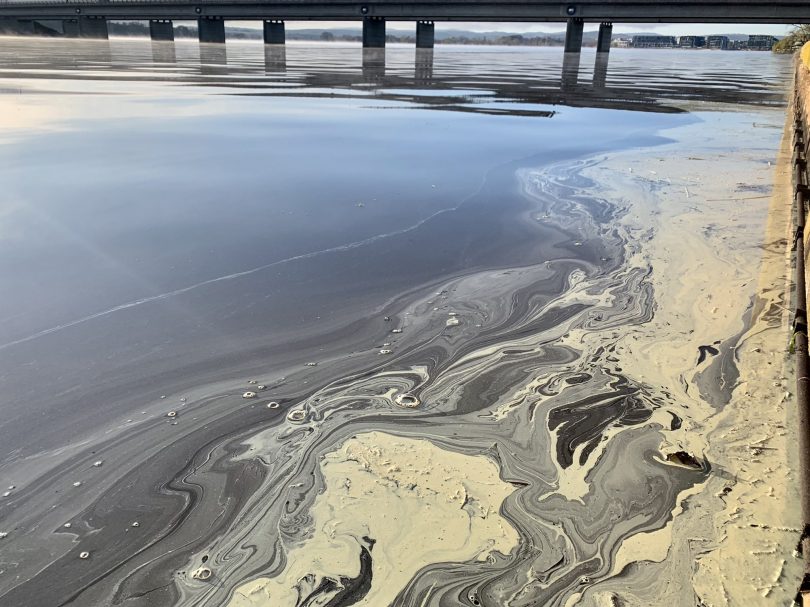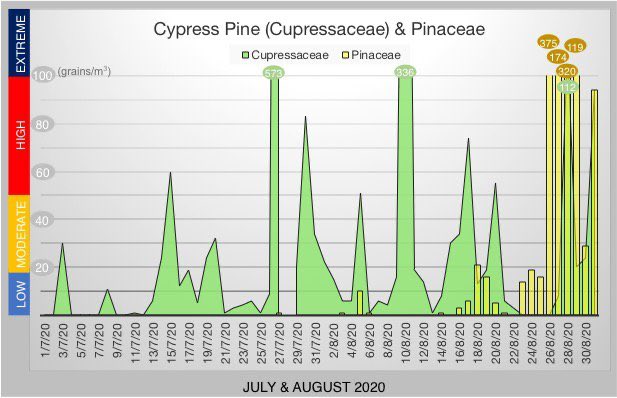
A stream of pollen on the foreshore of Lake Burley Griffin at the end of August. Photo: Simon Haberle.
Spring has sprung and on the very first day of the new season the ACT was hit with an extreme pollen count, giving hayfever sufferers the sniffles, watery eyes and a taste of what’s in store for the next few months.
Researcher and professor of natural history at the ANU Simon Haberle is Canberra’s very own pollinator. He’s been counting pollen particles for the past 13 years and says we are in for a bumper season of itchy eyes and swollen sinuses.
“There’s a cascade of different tree pollens that are happening at the moment,” Professor Haberle said.
“In previous years, mostly during the drought, the amounts of tree pollen were significant, but this year, the levels are even more so. It looks like a bumper season for tree pollen and we’re anticipating the same for grass coming up at the end of September and early October.”
Cypress Pine pollen cloud in #Canberra pic.twitter.com/zR3ABbiFj7
— Canberra Pollen (@CanberraPollen) July 27, 2020
Professor Haberle also runs an airborne pollen monitoring website Canberra Pollen which includes the Canberra Pollen App which allows people can keep track of high pollen days and know when to take action to stop hayfever in its tracks.
He said the main culprits are the pine trees, with the cypress the first to release its spores at the end of July. The bigger pines follow suit, and this year they have already released clouds of yellow ‘dust’ that has formed a slick on the surface of Lake Burley Griffin.
“What’s coming now are the elm trees and some people get allergic to that as well. The poplars, the ‘fluff trees’, do their thing usually in October, but that is actually seed and not pollen, but there is still a period of pollen for that tree in late September.
“We’ll also have the various grasses start seeding in late September and early October. The main type that causes allergies here is the ryegrass, with spores particularly prevalent during strong north-west winds,” Professor Haberle said.
Professor Haberle said one-in-three Canberrans suffer from allergic reactions to pollens, which makes the Territory a hotspot for hayfever. And if you’re wondering about the wattle, it is not a direct cause of hayfever as the spores are too large to enter our airways.
“People have all kinds of responses and it’s a complex area and unfortunately there’s not a one size fits all remedy for sufferers.
“What can help is going to your GP and getting an allergy test, or use the app to know when the pollen count is going to be extreme and you can be prepared with the appropriate medication,” he said.
Already, there have been seven days rated with an extreme level of pollen in the air (more than 100 pollen grains/m3) and 12 days with a high pollen count. The last week of August saw a succession of days with extreme levels which contributed to the yellow pollen dusting and slicks seen around the city.
Last year, there were only four days of extreme pollen levels. Professor Haberle said this is because of strong winds and high winter rainfall. Canberra received more than 140 mm in July and August this year compared with just 23 mm last year.

A summary of the pollen season in Canberra and the abundance of cypress pine and pine pollen from July-August. Image: Canberra Pollen.
Professor Haberle has been studying the impacts of changes to the environment since 2007 and particularly during the last five years with support from ACT Health, the National Health and Medical Research Council and the ANU.
He says there have been some very noticeable changes of late.
“We’re seeing some of the pollen seasons becoming longer and stronger, and they’re also starting earlier so that already points to climate change having a significant impact on pollen in the air,” he said.
A team of researchers are also digitising Canberra’s tree map so that people can further manage their symptoms, as well as conducting research on people’s allergies to plants.
“There’s very little known about Australian plants and how they allergenic they are, so a big part of the research we want to do is to explore what impact Australian native trees and introduced species have on people.”
Original Article published by Michael Weaver on The RiotACT.

